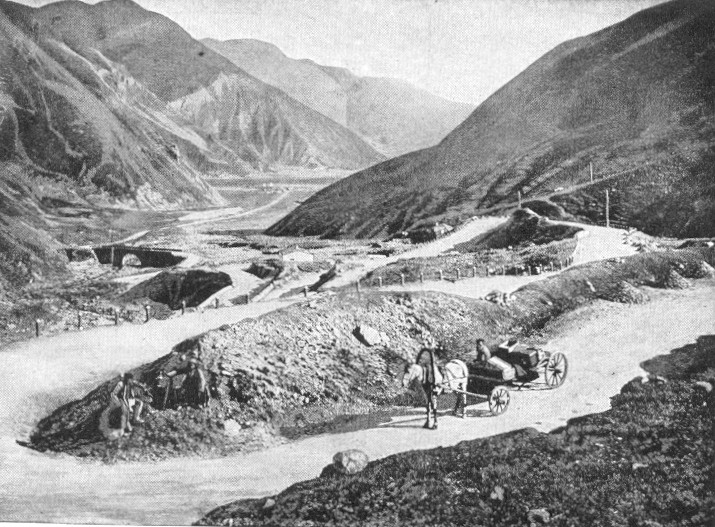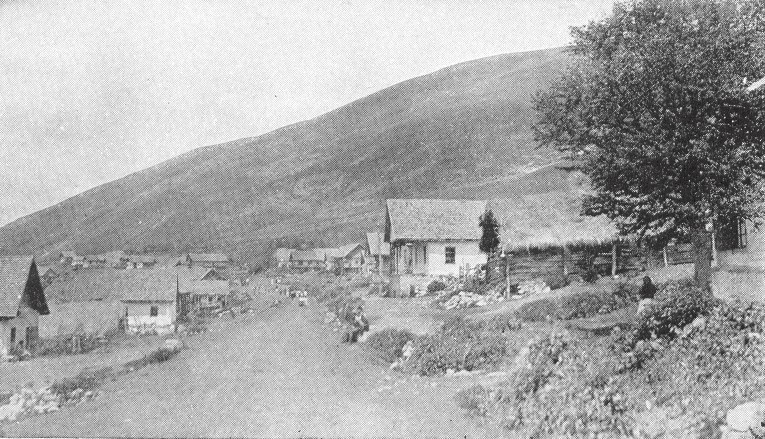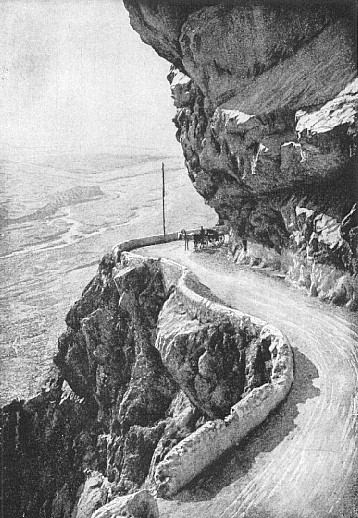Caucasus Roads
Click on Pictures to
Enlarge
|
 Hairpin
Bends on a Road Near Erivan [Erevan] Hairpin
Bends on a Road Near Erivan [Erevan]Erivan [Erevan] stand over three thousand feet above sea-level and from it the road winds down in long zigzags to the vale seen in the distance with harsh-featured hills dominating it on each hand. At the end of the road, eighty miles away, is the town of Kars, which is now a part of the Turkish Republic, though formerly it belonged to Russia. [Most Spiritual Christians who immigrated to America, fled from the Kars area due to the Ruso-Turkish war, prejudice, and economy.] |
 Village
of
The Molokans Or Quakers Village
of
The Molokans Or Quakers [In Old Russia, "Quaker" was a common derogatory synonym for Spiritual Christians, heretics, dissenters, Protestants, or any group which which protested against Orthodoxy or the state. This is the village of Voskresenovka, now Lermontovo, also shown between pages 18-19 in Pilgrims of Russian Town by P.V. Young, 1932, reissued, 1967, reprinted 1998.] In contrast to the many war-devastated villages are the near orderly ones of the [Spiritual Christians] Molokans and Jumpers who refused because of their religious beliefs to have any part in the fighting [of the Russo-Turkish War]. The Molokans, or Molokane [and Pryguny], are similar to the Quakers in their simple mode of life and in their practice of mutual help. Pryguny |
 "In the
mountainous districts, the houses
are built on
terraces, but
in the more prosperous places they are made of rough stone
or baked mud
and often have large wooden balconies around the first
floor, and
roofs of undulating red tiles. The houses of the rich are
often very
beautiful,
especially those which are decorated with colored glazed
tiles,
indicating
the Persian influence. "In the
mountainous districts, the houses
are built on
terraces, but
in the more prosperous places they are made of rough stone
or baked mud
and often have large wooden balconies around the first
floor, and
roofs of undulating red tiles. The houses of the rich are
often very
beautiful,
especially those which are decorated with colored glazed
tiles,
indicating
the Persian influence.
"We may see now and then a neat orderly village and we
learn
that these
are colonies of Germans who early in the nineteenth
century started to
the Holy Land because they had heard that the end of the
world was
near.
They traveled so slowly that agents who had been sent in
advance came
to
report to them that all was not as they believed in
Jerusalem and so
they
stayed where they were. They cultivated the land as they
had done in
Germany
and built their villages on the German plan and retained
their German
language,
although they have learned Russian and some have learned
Georgian. [These
Separatists
and Harmonists
prophesied the 2nd
coming of Christ
in 1836 on Mount Zion and influenced many Germans and
Pryguny
in the
south Ukraine, Milky Waters region, as they traveled
south from
Germany.
(Read more at: Hoffnungstal
-
1848
Village
History.) Their influence stimulated the
formation
of the Pryguny whose oral history reports a
"great outpouring of the
Holy
Spirit" during the same time and place. (Read more at:
Russians'
Secret,
Chapter 12.) Once in Georgia, the Harmonist
leader changed the location of 2nd coming of Christ
from Mount Zion,
Palestine
(now Israel), to be on Mount Ararat, Armenia, which
affected the
beliefs and behavior of Pryguny led by Maksim
G. Rudomyotkin. A sub-group of Separatists were Chiliasts, lead by Jung-Stilling. Berokoff reports in chapter 5: "...the book with a religious theme that enjoyed the widest popularity and even reverence among the elders previous to the publication of The Book of Spirit and Life in 1915, was a book on a mystical subject written by a German writer, Stilling Jung. ... concerning God's chosen people, their wandering from place to place in Europe and finding eventual haven in the Near East."] "One may see also villages where the Spiritual Christians Sources:
|
